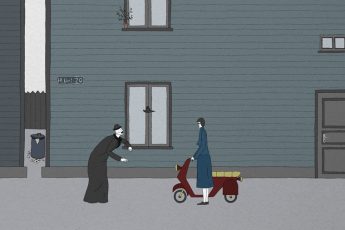Lucija Mrzljak on A Demonstration of Brilliance in Four Acts
Vol. 100 (December 2019) by Melina Tzamtzi
We met animation filmmaker Lucija Mrzljak at the Primanima film festival in Budaörs, where she presented the animated short “A Demonstration of Brilliance in Four Acts” (co-directed along with Morten Tšinakov). Mrzljak, who is originally from Croatia, explains how she ended up studying animation in Estonia and what her approach to making movies is, and shares her thoughts about the main ideas behind “A Demonstration”.
Why did you decide to do your MA in Animation in Estonia?
I used to study Animation in Zagreb, and I studied animation and illustration in Poland. In the beginning, I was experimenting and learning the techniques, and I was going to many animation film festivals watching many films – but I am also very interested in literature. I was very impressed by Estonian films because they resorted to such bizarre and interesting forms of storytelling, and since I was looking for a place to go and do my Masters at, this seemed to be the most interesting place to go to. I was lucky to work with Joonisfilmstudio during my studies because I got hands-on experience while seeing how more experienced filmmakers approached the process of filmmaking.
How do you believe that Pritt Pärn has affected your work?
When he was dismissed in 2016, many students were very sad because they were missing his guidance, and so they managed to bring him back. Many students wanted to have him as a tutor or an advisor and many of his students are now successful authors. He really put in a lot of energy in his teaching, giving his students the freedom to develop their own styles. What is most interesting about his teaching is that he teaches classes on storyboarding: you spend time in groups, writing and writing, becoming familiar with the process of storytelling and exchanging ideas about the weak and strong points of each and every story, which is a process that involves a lot of brainstorming and communication.
Olga Pärn has said in an interview that the Estonian language has a special logic, allowing you to play with words. Would you agree with this characterization of the Estonian language?
When I came to Estonia, I didn’t speak the language at all, but now I’ve been living in Estonia for almost five years and I understand Estonian. I don’t speak perfectly but I’ve been learning, and I can say that this is true: the Estonian language is really playful, and the meanings can sometimes be different. I also think that the language defines how people think and within the images and the films, a lot of things have double meanings. For instance, many jokes have double meanings. I do think it’s a noticeable difference vis-à-vis English or Croatian.
You said during the masterclass that for you, “drawing is thinking”. If drawing is thinking for you, what is the language you draw in?
Language is thinking too, but they each have their own limitations, possibilities and connections. Sometimes it is impossible to make a division and be sure of whether you’re thinking in images or words. It’s interconnected. But what I wanted to say by “drawing is like thinking” is that during the process you get ideas. When you draw, you get ideas that you develop by drawing. I think my film Corner is characteristic of this “Drawing is thinking” process because there are some simple lines, and when you draw, you’re like, “actually this circle can be a hole”. When you’re thinking you can rearrange events – what could happen next? But now I’m more interested in a more complex form of storytelling, like the one in A Demonstration of Brilliance in Four Acts. You open more registers and possibilities if you also work with words. In any case, it is a journey, so there is no special recipe or a perfect way of making films, I’m still in the process of discovering things.
The advice that Pritt Pärn gave in an interview for young animators and debutants is “trust yourself or don’t trust yourself, and read books” – what is yours?
This is very beautiful, what he said. People go to animation schools thinking that they’re going to learn something and yes, it’s good, but it is no guarantee. It’s all about how engaged you are, how interested you are and how hard you work. You just have to be open-minded and seek out your personal way. I think there is no real recipe. What he was saying is “don’t be too sure”/ “always question yourself”. I also like the part about reading books a lot. People read less and less, while I think we should read more and more because it opens your mind, your experience to other worlds.
How did you come up with the story of Forest, and how have Pritt & Olga Pärn helped you execute the idea?
That was my student film, in which I combined some dreams I had had. Sometimes I write them down and then sometimes I combine some motifs of the films and try to form them into a story, and this was the beginning of the film. And then I tried to combine it into a narrative, a rather open one because dreams are difficult to explain and I wanted to make a dreamy film, not so much explicable. As my tutors, they helped me with the storyboard, they gave me advice on the weaker and stronger points and Olga helped me with the technical side and the editing, because I made the whole thing on paper. It was a really slow procedure, involving a lot of drawing and scanning, but I really liked it because the contact of the paper is really special, and the effect of the hand is very natural.
The love of unmatched beings depicted in Forest is a prevalent theme in fairy tales. It reminded me of a Greek one focused on the love between a horse and a poplar, and of the little prince and his rose on his lonely planet. Usually these stories don’t have “happy endings”, their conclusions are somehow bittersweet. Do you believe that Forest also has a similar ending?
It is a theme that you can easily find in literature and old stories. Yes, I think the ending is bittersweet, there was this friendship which was special and which ended, but which also kept living on in the heart. Life goes on but you’re lucky if such things happen to you.
The music by Sofia Garcia is also very charming. Why did you choose the sound of the accordion?
Sofia Garcia is from the Canarians and she was studying music in the Estonian musical academy. She plays the accordion, that is her specialty. And we met by complete accident through a common friend. I showed her the paintings and we began collaborating. She made several versions and then we chose this one. I was looking for someone who plays the accordion, I don’t know why exactly. I come from Croatia and my father used to play it and I had a special connection with this instrument. It was an intuitive choice, I guess.
While Forest is about two beings unmatched, a lady and a tree, there is a certain homogeneity to A Demonstration of Brilliance in Four Acts – the male characters look identical while the man and the woman come to literally be a “match”. Was this homogeneity an aesthetic or a narrative choice?
I think both. The structure was quite an important and interesting part of the film. There is a certain structure that you try to follow and through which you try and make connections. There is the idea that those characters, the almost identical ones, are meant for each other. But there is also the other couple that meet in a somehow disgusting way, and the irony is that they are the ones who survive while the other ones are not so lucky.
How did you come up with the title? The characters are not brilliant, on the contrary they are constantly failing. Do you believe that brilliance is doomed to fail?
The title is misleading. First of all, there aren’t 4 acts. The “brilliance” concerns the protagonist, this man followed by the big crowd who thinks that he and everything he does is brilliant. It was some kind of a parody of people who think that some people, say celebrities, are born special – and really from the point of the crowd they are not important, they are only admired, even though they don’t do anything particularly special. In the beginning he’s doing some movements and later, he repeats them and so does the woman to save the big crowd from the collapsing pillar – he is mute, and she can shout. Nothing is brilliant, which is also true of real life. Brilliance is a concept, people think something can be completely perfect but humans are bound to make mistakes.
Yours is an absurd film that follows the tradition of the absurdity of Estonian animators. For me, this universe was very Kafkaesque – meaning that nothing makes sense on the surface, but at the same time it totally does, like a parallel universe where you have never been even though it is readily recognizable. Do you believe that there is a certain kind of absurdity in art emanating from the countries of the former Eastern bloc, and if so, why?
Me and my co-director Morten Tchinakov, we admire Eastern European literature and films a lot, and there is indeed quite a tradition of surreal humor. We also like the writer Daniil Charms, whose influence is definitely in the film, and a lot of Croatian writers. But yes, in the Eastern European bloc, this approach to storytelling and this kind of dark humor have a long tradition. Maybe it comes from our languages, maybe it came later, but one element is important to mention. In Communism, there was a lot of censorship and so artists, caricaturists and writers would have to find smart ways to draw or write something so that it could have a second meaning in order to hide the truth behind the surface. Also, maybe it has to do with Europe’s difficult past, maybe that’s why they try to joke – humor is essential for going through difficult times.
What is your relationship to absurdity? What can absurdity teach us?
Life is absurd and that’s why it is beautiful. Absurdity can teach us to look at things from different angles, for things are not always what they seem.




Leave a Comment